Samsung Galaxy Tab Pro 8.4 and 10.1 Review
by Jarred Walton on March 22, 2014 9:30 PM ESTLCD Testing: A Feast for Your Eyes
Let’s start out the testing by going straight to the biggest draw with the Galaxy Pro tablets: the WQXGA displays. Even without testing, I could see by looking that the colors on the Pro 10.1 looked a bit better/more natural than on the Pro 8.4, but I was curious to see if the colors were truly accurate or merely not as oversaturated. Depending on your display setting, it’s a little of both.
I tested the Pro 10.1 in four modes (“Auto”, Dynamic, Standard, and Movie), and contrary to what I’ve seen reported elsewhere, the Movie mode resulted in the most accurate colors. Most tablets and laptops often use white points that are far too hot (blue), and that applies to the 10.1 on the Dynamic and Standard modes, though Standard is a bit better perhaps; it also applies to the Pro 8.4 display. The Movie mode on the other hand clearly reduces the saturation levels and ends up being very good overall. Here are five sets of galleries showing the testing results for the various display modes on the 10.1 as well as the sole mode on the 8.4.
As for brightness, contrast, and DeltaE results, both models do reasonably well, again with the color accuracy advantage going to the 10.1. Keep in mind that the only other tablets in these charts just happen to be some of the best displays on the market, with the iPad Air being factory calibrated and the Nexus 7 being one of the best non-Apple devices in terms of color accuracy.
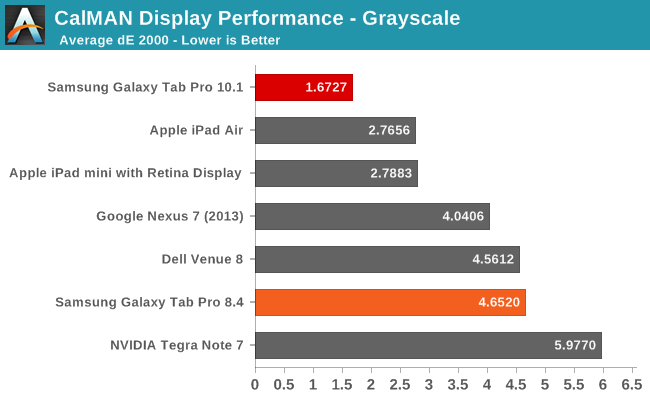
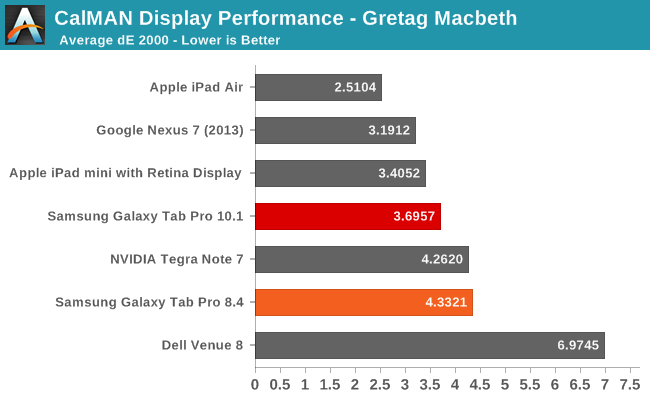
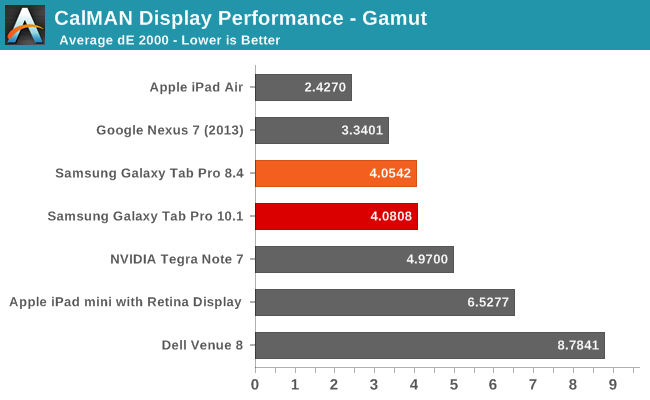
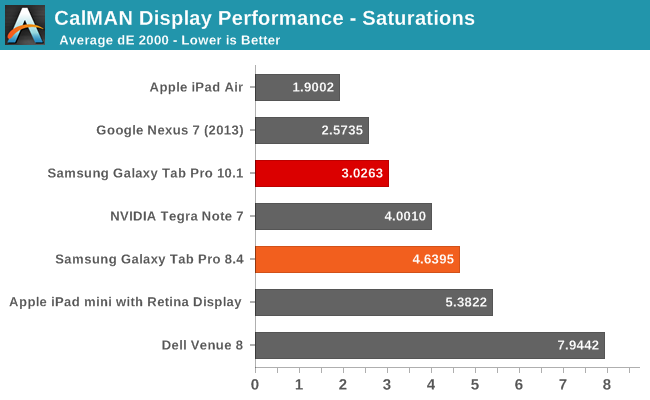
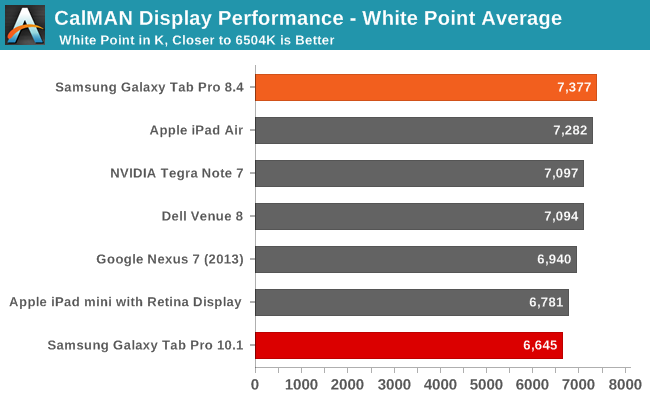
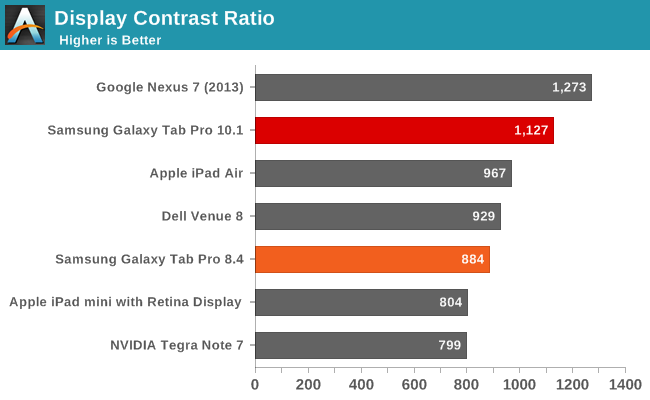
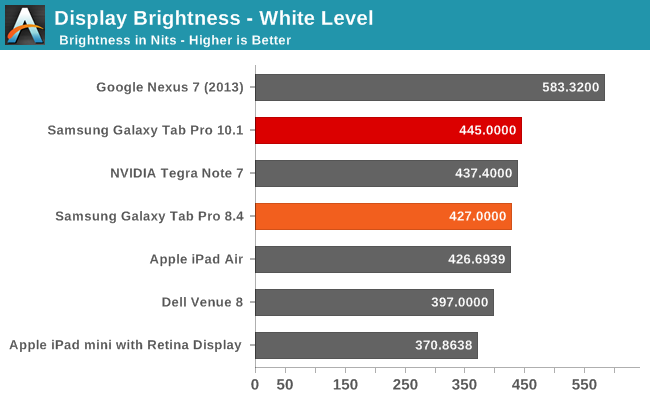
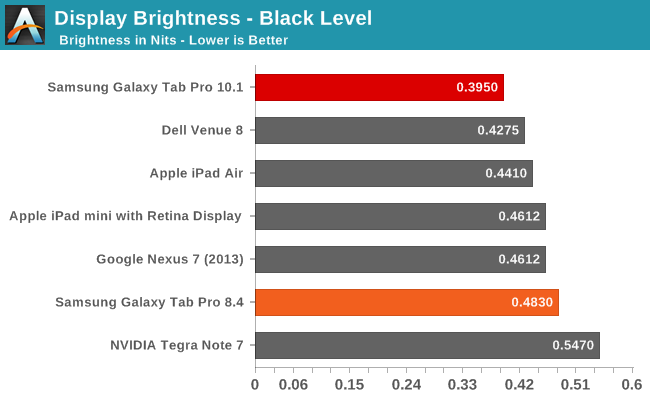
While none of the results are necessarily standouts (other than the grayscale dE 2000 on the Pro 10.1), we again have to keep in mind the fact that these are 2560x1600 panels in 10.1 and 8.4 inch devices. Factory calibration would push them over the top, but even without that they’re going to provide a wow factor to anyone used to lower resolution, lower quality displays.








































125 Comments
View All Comments
TestKing123 - Tuesday, March 25, 2014 - link
It's true the Yogo 2 Pro is in an entirely different segment/market than an Ipad or Android tablet, but I found I'm using this device far more often than any of my other tablets. The screen is 13.3 but a beautiful QHD display (higher than Retina), very responsive and incredibly fast. The major apps are all on Windows 8 anyways, though I don't care for the App store that much. I can use it as a tablet or PC with a flip of the backside, and I can run all my business software AND play some decent PC games as well.It literally made by tablet collection (and I love buying the newest tablets) obsolete.
johnny_boy - Sunday, March 23, 2014 - link
I think the lg g pad 8.3 makes a good lower cost competitor to the tab pro 8.4. It's sporting previous gen snapdragon soc but 2gb ram and basically the same dimensions and weight. I personally don't think the extra cost of the tab is worth it over the g pad.RobilarOCN - Monday, March 24, 2014 - link
Have you owned a G Pad? I recently sold mine and switched to the Tab Pro 8.4. You might want to have a look at the XDA forum section for it. Despite an amazing aluminum body, the screen on the G Pad is terrible. I paid $350 for it (got it before LG heavily discounted it and then released the google play edition). It is hands down the dimmest tablet screen I have ever used. I was lucky enough not to get one of the "crappy" ones (of which there are apparently many), I didn't have the blue line of doom on the screen or excessive light bleed around the edges (Both of which are very common). Still, even at 100% brightness, it is dimmer than a Nexus 7 or a tab pro at 50%. Impossible to use in sunlight (I took it on vacation). Also the battery life was not good. There is a reason that LG dropped the tablet price by $100 within a month of it's release. Too bad because it has a lot of other amazing things going for it. The screen is the deal breaker though. So yes, the extra cost makes it a big difference... Plus LG is discontinuing the $250 version in favor of the $350 google play edition. A $50 difference for a vastly better screen, faster SOC and better battery? Abolutelywintermute000 - Monday, March 24, 2014 - link
if u can't ROM away the custom magazine UI then no sale. Haven't kept up but aren't Sammy devices getting harder and harder to mod?Woody - Sunday, March 23, 2014 - link
Haha!! what age do you consider "getting old"This is exactly what I'm thinking when I look at screen size these days....thinking about switching from my Galaxy S series for a Galaxy Note for this very reason.
Or I could just get reading glasses. ughh!
frozentundra123456 - Sunday, March 23, 2014 - link
Nice, but more than I would pay for any android device.martixy - Monday, March 24, 2014 - link
That moment when you skim the specs and notice that the display size is always bigger than the stated physical dimensions of the device.It takes a second...
skrewler2 - Friday, March 28, 2014 - link
You mentioned the Note 2014 having the same specs on the first page, but didn't include these in any of the benchmarks to confirm they are indeed the same tablet with just the inclusion of the S-Pen?Also, you didn't include a comparison between the Note / Note pro / Galaxy / Galaxy pro in your closing thoughts.
I got my Galaxy Note 10.1 2014 edition on special for $400 back in Jan (also w/ a bunch of goodies.. Google store credit, Samsung store credit, Dropbox, evernote pro, a bunch of other stuff). I was kinda bummed that shortly after I purchased it that the Note Pros came out, but other than 10" vs 12" it's hard to tell what exactly is different between them. I remember coming to the conclusion that the Pro model adds some features for businesses / BYOD, notably for compliance and security.
Does it just come down to Note 10.1 2014 being 10" and Note Pro 12 being 12"? Doesn't seem worth the $300 price premium. I also just ran the Sunspider benchmark on my Note 2014 and consistently get scores around 500ms.
maximumGPU - Monday, March 24, 2014 - link
Thumbs up to Jarred for being very active on the comments section and replying to questions or concerns.az_ - Monday, March 24, 2014 - link
I am wondering, why aren't you comparing these Pro tablets to something with Windows, just to other android tablets and the iPad? I guess if someone is trying to use a tablet to do work the Surface Pro 2, Surface 2 and Dell Venue Pro 8 would be on his radar as well.Some of the benchmarks are cross platform (all browser based ones) and you can run an emulator for android and run the benchmarks on x86 windows.
Come on guys, be a bit more creative with the reviews.